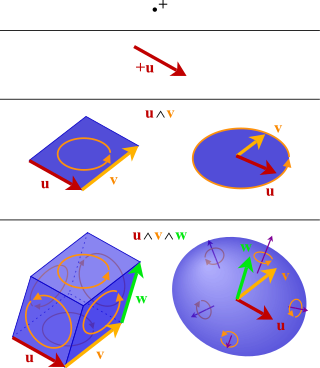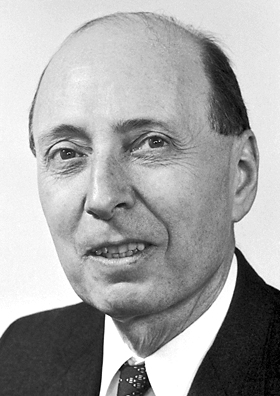This article needs additional citations for verification .(June 2021) |
In functional analysis, a branch of mathematics, a finite-rank operator is a bounded linear operator between Banach spaces whose range is finite-dimensional. [1]
This article needs additional citations for verification .(June 2021) |
In functional analysis, a branch of mathematics, a finite-rank operator is a bounded linear operator between Banach spaces whose range is finite-dimensional. [1]
Finite-rank operators are matrices (of finite size) transplanted to the infinite dimensional setting. As such, these operators may be described via linear algebra techniques.
From linear algebra, we know that a rectangular matrix, with complex entries, has rank if and only if is of the form
The same argument and Riesz' lemma show that an operator on a Hilbert space is of rank if and only if
where the conditions on are the same as in the finite dimensional case.
Therefore, by induction, an operator of finite rank takes the form
where and are orthonormal bases. Notice this is essentially a restatement of singular value decomposition. This can be said to be a canonical form of finite-rank operators.
Generalizing slightly, if is now countably infinite and the sequence of positive numbers accumulate only at , is then a compact operator, and one has the canonical form for compact operators.
Compact operators are trace class only if the series is convergent; a property that automatically holds for all finite-rank operators. [2]
The family of finite-rank operators on a Hilbert space form a two-sided *-ideal in , the algebra of bounded operators on . In fact it is the minimal element among such ideals, that is, any two-sided *-ideal in must contain the finite-rank operators. This is not hard to prove. Take a non-zero operator , then for some . It suffices to have that for any , the rank-1 operator that maps to lies in . Define to be the rank-1 operator that maps to , and analogously. Then
which means is in and this verifies the claim.
Some examples of two-sided *-ideals in are the trace-class, Hilbert–Schmidt operators, and compact operators. is dense in all three of these ideals, in their respective norms.
Since any two-sided ideal in must contain , the algebra is simple if and only if it is finite dimensional.
A finite-rank operator between Banach spaces is a bounded operator such that its range is finite dimensional. Just as in the Hilbert space case, it can be written in the form
where now , and are bounded linear functionals on the space .
A bounded linear functional is a particular case of a finite-rank operator, namely of rank one.
Bra–ket notation, also called Dirac notation, is a notation for linear algebra and linear operators on complex vector spaces together with their dual space both in the finite-dimensional and infinite-dimensional case. It is specifically designed to ease the types of calculations that frequently come up in quantum mechanics. Its use in quantum mechanics is quite widespread.
In mathematics, any vector space has a corresponding dual vector space consisting of all linear forms on together with the vector space structure of pointwise addition and scalar multiplication by constants.
In mathematics, a self-adjoint operator on a complex vector space V with inner product is a linear map A that is its own adjoint. If V is finite-dimensional with a given orthonormal basis, this is equivalent to the condition that the matrix of A is a Hermitian matrix, i.e., equal to its conjugate transpose A∗. By the finite-dimensional spectral theorem, V has an orthonormal basis such that the matrix of A relative to this basis is a diagonal matrix with entries in the real numbers. This article deals with applying generalizations of this concept to operators on Hilbert spaces of arbitrary dimension.
In mathematics, specifically functional analysis, a trace-class operator is a linear operator for which a trace may be defined, such that the trace is a finite number independent of the choice of basis used to compute the trace. This trace of trace-class operators generalizes the trace of matrices studied in linear algebra. All trace-class operators are compact operators.

In mathematics, the exterior algebra or Grassmann algebra of a vector space is an associative algebra that contains which has a product, called exterior product or wedge product and denoted with , such that for every vector in The exterior algebra is named after Hermann Grassmann, and the names of the product come from the "wedge" symbol and the fact that the product of two elements of is "outside"

In mathematics, a differential operator is an operator defined as a function of the differentiation operator. It is helpful, as a matter of notation first, to consider differentiation as an abstract operation that accepts a function and returns another function.
In linear algebra and functional analysis, the partial trace is a generalization of the trace. Whereas the trace is a scalar-valued function on operators, the partial trace is an operator-valued function. The partial trace has applications in quantum information and decoherence which is relevant for quantum measurement and thereby to the decoherent approaches to interpretations of quantum mechanics, including consistent histories and the relative state interpretation.
In mathematics, the spectrum of a C*-algebra or dual of a C*-algebraA, denoted Â, is the set of unitary equivalence classes of irreducible *-representations of A. A *-representation π of A on a Hilbert space H is irreducible if, and only if, there is no closed subspace K different from H and {0} which is invariant under all operators π(x) with x ∈ A. We implicitly assume that irreducible representation means non-null irreducible representation, thus excluding trivial (i.e. identically 0) representations on one-dimensional spaces. As explained below, the spectrum  is also naturally a topological space; this is similar to the notion of the spectrum of a ring.
In quantum information theory, a quantum channel is a communication channel which can transmit quantum information, as well as classical information. An example of quantum information is the general dynamics of a qubit. An example of classical information is a text document transmitted over the Internet.

The Lorentz group is a Lie group of symmetries of the spacetime of special relativity. This group can be realized as a collection of matrices, linear transformations, or unitary operators on some Hilbert space; it has a variety of representations. This group is significant because special relativity together with quantum mechanics are the two physical theories that are most thoroughly established, and the conjunction of these two theories is the study of the infinite-dimensional unitary representations of the Lorentz group. These have both historical importance in mainstream physics, as well as connections to more speculative present-day theories.
In mathematics, and in particular functional analysis, the tensor product of Hilbert spaces is a way to extend the tensor product construction so that the result of taking a tensor product of two Hilbert spaces is another Hilbert space. Roughly speaking, the tensor product is the metric space completion of the ordinary tensor product. This is an example of a topological tensor product. The tensor product allows Hilbert spaces to be collected into a symmetric monoidal category.

Wigner's theorem, proved by Eugene Wigner in 1931, is a cornerstone of the mathematical formulation of quantum mechanics. The theorem specifies how physical symmetries such as rotations, translations, and CPT transformations are represented on the Hilbert space of states.
In mathematics, particularly in operator theory, Wold decomposition or Wold–von Neumann decomposition, named after Herman Wold and John von Neumann, is a classification theorem for isometric linear operators on a given Hilbert space. It states that every isometry is a direct sum of copies of the unilateral shift and a unitary operator.
In the mathematical discipline of functional analysis, the concept of a compact operator on Hilbert space is an extension of the concept of a matrix acting on a finite-dimensional vector space; in Hilbert space, compact operators are precisely the closure of finite-rank operators in the topology induced by the operator norm. As such, results from matrix theory can sometimes be extended to compact operators using similar arguments. By contrast, the study of general operators on infinite-dimensional spaces often requires a genuinely different approach.
In mathematics, particularly in the theory of C*-algebras, a uniformly hyperfinite, or UHF, algebra is a C*-algebra that can be written as the closure, in the norm topology, of an increasing union of finite-dimensional full matrix algebras.

In the context of quantum mechanics and quantum information theory, symmetric, informationally complete, positive operator-valued measures (SIC-POVMs) are a particular type of generalized measurement (POVM). SIC-POVMs are particularly notable thanks to their defining features of (1) being informationally complete; (2)having the minimal number of outcomes compatible with informational completeness, and (3) being highly symmetric. In this context, informational completeness is the property of a POVM of allowing to fully reconstruct input states from measurement data.

In mathematics, Hilbert spaces allow the methods of linear algebra and calculus to be generalized from (finite-dimensional) Euclidean vector spaces to spaces that may be infinite-dimensional. Hilbert spaces arise naturally and frequently in mathematics and physics, typically as function spaces. Formally, a Hilbert space is a vector space equipped with an inner product that induces a distance function for which the space is a complete metric space. A Hilbert space is a special case of a Banach space.

The theory of causal fermion systems is an approach to describe fundamental physics. It provides a unification of the weak, the strong and the electromagnetic forces with gravity at the level of classical field theory. Moreover, it gives quantum mechanics as a limiting case and has revealed close connections to quantum field theory. Therefore, it is a candidate for a unified physical theory. Instead of introducing physical objects on a preexisting spacetime manifold, the general concept is to derive spacetime as well as all the objects therein as secondary objects from the structures of an underlying causal fermion system. This concept also makes it possible to generalize notions of differential geometry to the non-smooth setting. In particular, one can describe situations when spacetime no longer has a manifold structure on the microscopic scale. As a result, the theory of causal fermion systems is a proposal for quantum geometry and an approach to quantum gravity.
This is a glossary for the terminology in a mathematical field of functional analysis.
Tau functions are an important ingredient in the modern mathematical theory of integrable systems, and have numerous applications in a variety of other domains. They were originally introduced by Ryogo Hirota in his direct method approach to soliton equations, based on expressing them in an equivalent bilinear form.